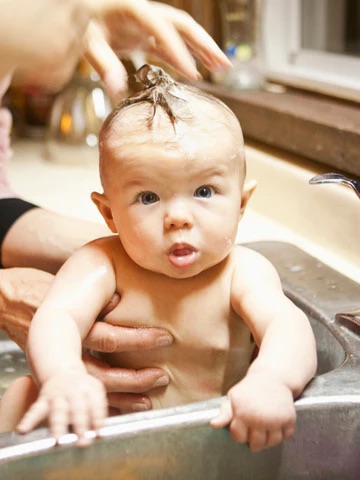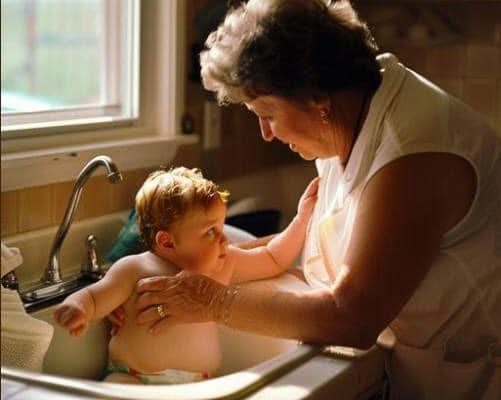When I saw my mother-in-law bathing my son in the kitchen sink, I was horrified. The same sink where we wash dishes and prepare food! This led me to question: can you bathe a baby in the sink?
Surprisingly, it’s a common question among new parents, and even our own parents might have pondered it when we were babies.
Bathing a baby in the sink has been a tradition for generations, long before the nursery industry exploded with baby essentials.
Many families back then didn’t have baby bathtubs, so the sink was a practical alternative. Today, despite the availability of baby bathtubs, some parents still find sink baths convenient.
There are several reasons why new parents might consider sink baths for their babies. Some households only have a shower and no bathtub, making the sink a viable option.
Other parents might not have a baby bath ready when they bring their newborn home. Additionally, sink baths can be seen as a continuation of a family tradition.

Pros of Sink Baths:
- Less Water Usage: Sinks are smaller than baby bathtubs, meaning less water is needed. This is great for saving on water bills and is also environmentally friendly.
- Ease on the Back: Standing at the sink is often easier on your back compared to bending over a bathtub on the floor. This can be particularly beneficial for new mothers recovering from a c-section.
- Quick and Convenient: Filling the sink is faster and less hassle than setting up a baby bathtub. You can have all your baby’s bath supplies ready on the draining board for easy access.
Cons of Sink Baths:
- Temperature and Location: Kitchen sinks are often near windows, which can be drafty in cooler weather. Baby bathtubs, however, can be moved to any part of the house, making it easier to control the bathing environment.
- Size and Shape: Not all sinks are suitable for baby baths. Sinks vary in size and depth, unlike baby bathtubs which are designed to be safe and comfortable for small babies.
- Cleanliness: You must thoroughly clean the sink before and after bathing your baby to ensure it’s hygienic. This means considering what cleaning products you use, as you don’t want to expose your baby to harsh chemicals.
While bathing a baby in the sink can be convenient, it’s essential to weigh the pros and cons. Ensure the sink is clean and safe, and consider the environment and comfort of your baby.
If these factors align, a sink bath can be a practical solution. However, if the sink isn’t suitable or if you’re uncomfortable with the idea, investing in a baby bathtub might be the better choice.
So, while my initial reaction to my mother-in-law’s actions was shock, understanding the context and reasoning behind sink baths helped me see that it’s a common practice with both benefits and drawbacks. Ultimately, it’s about what works best for you and your baby.




